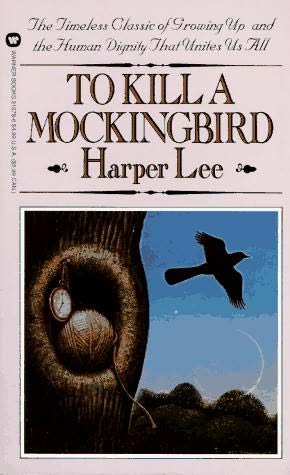Victimizing the Inocent
Essay Exam
By: Me
In Harper Lee’s, To Kill a Mockingbird, the reoccurring motif of “to kill a mockingbird” first becomes evident when Atticus teaches Jem and Scout a lesson— never harm the innocent—which is both directly and indirectly referenced throughout part one and two as the children learn to treat others fairly, while the rest of the town is stuck in their “disease” of prejudice—treating people insensitively because of their looks or simply because they see others treating people wrongfully. When this major theme is first introduced on page 10, Atticus gets his children air rifles for Christmas. He is quick to quietly teach them that shooting at mockingbirds is a sin because all they do is sing lovely music for us and cause no harm. Jem and Scout realize what he is saying about the birds; however, it is only until later in part two that they come to see that this symbol refers to humans as well. For example, two main characters—Arthur “Boo” Radley and Tom Robinson—are the central characters of their own plot; until, at the very end, the two parts unify resulting in Jem and Scout growing up with a better understanding of how the prejudiced world around them affects the innocent mockingbirds.
In part one of To Kill a Mockingbird, the children know the mysterious man living next door as “Boo;” here, he serves as just a superstition, enamoring them. The children play stealthily and are a vexation and provocation to him, leaving him far from placid. They are curious because they have never seen Boo before; he is said to be nocturnal. However, as Jem particularly realizes, Boo is trying to befriend the children. Although he never reveals himself to Jem and Scout yet, he gives them gifts (Page 57-63-Chapter 7), puts a blanket on Scout (Page 71-72),etc.—something that only a mockingbird, someone who cares, loves, and protects, would do. Ultimately, Boo does protect the children from Bob Ewell (Pages 261+262). Here, Scout sees Boo not as a ghost anymore, but rather, as Arthur Radley. Later in part two, Arthur is cared about by Heck Tate and Atticus when it is decided that Bob Ewell fell on his knife. This was to protect Arthur from the world that he did not know and the world that did not know him; whereas in part one, gossip stories were made up about Boo. For this reason, Jem realizes why Boo stayed in his house all of these years; this shows Jem’s growing up and maturing. At the very end of the novel (Page 278+279), Scout walks Arthur home; standing on his front porch, she realizes how he sees Maycomb; this shows her growing up and maturing.
In part two of To Kill a Mockingbird, Tom Robinson is the symbolized mockingbird. Atticus is appointed to defend Tom in court although he knew that it would be formidable; the whites were always auspicious when versus a black. Tom, being the kind man that he is, was only trying to help Mayella Ewell when she attacked him. Because Tom is black and Mayella is white, it is her side of the story that is believed by the jury—that Tom raped her. Although it is obvious to those who are “free from Maycomb’s disease” that he did not commit any crime, the jury—whites—are prejudiced and therefore see right past the evidence that Tom could not possibly have done such a thing, for his left arm is impaired. Tom is innocent, yet is victimized because of the jury.
Although there are two parts to To Kill a Mockingbird, their relationship becomes evident towards the end of part two. All of the kind acts that Boo does in part one foreshadow his main gift to the children—their lives. Although part one is mainly Boo’s plot, Jem and Scout are criticized by the town’s people of Maycomb about their father being a “nigger-lover.” The title—To Kill a Mockingbird—foreshadows that someone innocent gets killed. As it turns out, this is what happens to Tom—an example of a mockingbird in the novel. However, Boo and Tom are not the only mockingbirds; Atticus can be considered one too because is glad to get spat in the face by Bob instead of Mayella getting beaten.
Although there are two parts to To Kill a Mockingbird, their relationship becomes evident towards the end of part two. All of the kind acts that Boo does in part one foreshadow his main gift to the children—their lives. Although part one is mainly Boo’s plot, Jem and Scout are criticized by the town’s people of Maycomb about their father being a “nigger-lover.” The title—To Kill a Mockingbird—foreshadows that someone innocent gets killed. As it turns out, this is what happens to Tom—an example of a mockingbird in the novel. However, Boo and Tom are not the only mockingbirds; Atticus can be considered one too because is glad to get spat in the face by Bob instead of Mayella getting beaten.
The lesson of “to kill a mockingbird,” or never harm the innocent, that Jem and Scout first learn from their father, serves as the basis of Jem and Scout’s growing up to realize how their town has the “disease” of prejudice but that the right thing to do is treat others fairly—not only in the court. Without this wisdom in part one, the children treat Boo as the rest of the town does; however, after saving their lives, Scout realizes to treat not only him but everybody with respect—even a back.
 |  |